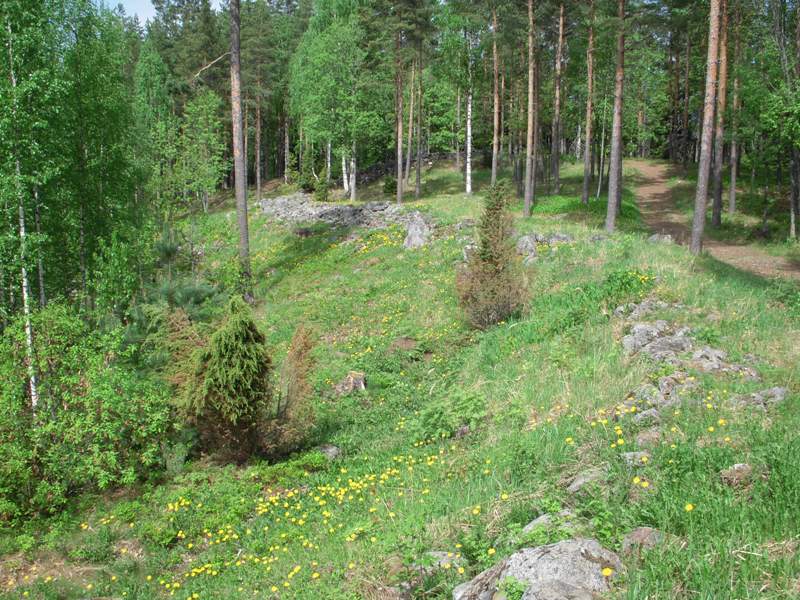Mysterious Prehistoric Sites of Finland
There is no written history of Finland before the late Middle Ages. However, this northern land was ruled by local landlords. These ancient sites are the traces and remains of past generations. They tell about life, habitation, communications, trades and occupations, religion and the burial of the dead in the past.

Sammallahdenmäki
Sammallahdenmäki is a Bronze age burial site including 36 granite burial cairns dating back more than 3000 years, from 1500 to 500 BC. Sammallahdenmäki is an exceptionally valuable example of Finland’s Bronze Age culture because it presents the ancient monuments in a well-preserved natural milieu.
Read more about Sammallahdenmäki
Rapola Hill Fort
The hill fort in Rapola Ridge the largest ancient fort in Finland. As is the case with most hill forts in the Baltic area not much is known about its exact origins or purposes. One postulation is that it was built by the inhabitants in their struggles against invading Novgorodians and Swedes.
Read more about Rapola Hill Fort
Hakoinen Castle
Hakoinen Castle was an ancient hill fortification, but nowadays there's only some ruins left. Dated medieval, the fortification was situated on a very steep rock by lake Kernaala (Kernaalanjärvi) reminiscent of a hill fort tradition. The top of the rock is 63 meters above the water level in the lake.
Read more about Hakoinen Castle
Sulkava Hill Fort
The hill fort is located to the rock hill with high cliffs in Pisamalahti. The hill fort rises about 55 meters above Enovesi lake.First record of the fort dates back to the year 1561, but it was probably built in the Iron or Middle Ages.
Read more about Sulkava Hill Fort
Ukonkivi
Ukonkivi is a small island in the Inarijärvi lake. It has been a well-known sacrifice place ("seita") for the Samish people for centuries. There are several caves where local people used to bring gifts to Ukko, the god of thunder.
Read more about Ukonkivi
Värikallio Rock Paintings
The Hossa Värikallio rock paintings are amongst the largest prehistoric rock paintings in Finland. The pictures on the rock wall rising from Lake Somerjärvi were painted in the Stone Age, i.e. about 3,500 - 4,500 years ago.Paintings were painted from a boat or when standing on the ice of the lake.
Read more about Värikallio Rock Paintings
Kuninkaanhauta
Kuninkaanhauta ("King's Grave") is the largest Bronze Age cairn in Finland. The stone huddle is 36x30 meters wide and four meters high. According the legend a local king or chief is buried to the cairn. It's quite probable several burials are made to Kuninkaanhauta during decades or centuries and it's expanded little by little.
Read more about Kuninkaanhauta
Susiluola (Wolf Cave)
Susiluola (Wolf Cave) is a crack in the Pyhävuori mountain. The upper part of the crack has been packed with soil, forming a cave. In 1996, some objects were found in the cave that brought about speculations that it could have been inhabited in the Paleolithic, 120,000 to 130,000 years ago.
Read more about Susiluola (Wolf Cave)
Stone Age Ruin of Kastelli
So-called Jätinkirkko (“the giant’s church”) of Kastelli is a rectangular stone rampart measuring 36 x 62 meters. It dates back to the Stone Age and is one of the most significant ancient structures in Finland. The fort was probably built between 2700-2200 B.C like most of the stone constructions in northern Botnia.The structure is located at top of the hill.
Read more about Stone Age Ruin of Kastelli
Astuvansalmi Rock Paintings
The 65 rock paintings of Astuvansalmi are the largest found in the whole of Scandinavia. The oldest paintings are made 3000 - 2500 BC. They are located at the highest level (about 11 metres). The water level changed very fast about 2,5 metres with the landslide of Vuoksi. Later on the level slowly went down 8 metres to its present level.
Read more about Astuvansalmi Rock Paintings
Rikalanmäki
Rikalanmäki was one of the most remarkable Bronze and Iron Age towns in Finland. According legends, It was a very wealthy trading centre. The heyday of Rikalanmäki was in 11th and 12th centuries when Vikings and foreign merchants exchanged metals and weapons to fur from inner Finland. There are evidences of indirect trade connections even to the Arabic countries.
Read more about Rikalanmäki
Levänluhta
Levänluhta is a swampy source known for mysterious prehistoric findings. According archaeological excavations about hundred people have been buried to the former lake of Levänluhta in the Iron Age. Archaeologists have also found several remains of bronze and silver jewelry and tools.There are remains of buried children, elderly and animals of different ages.
Read more about Levänluhta